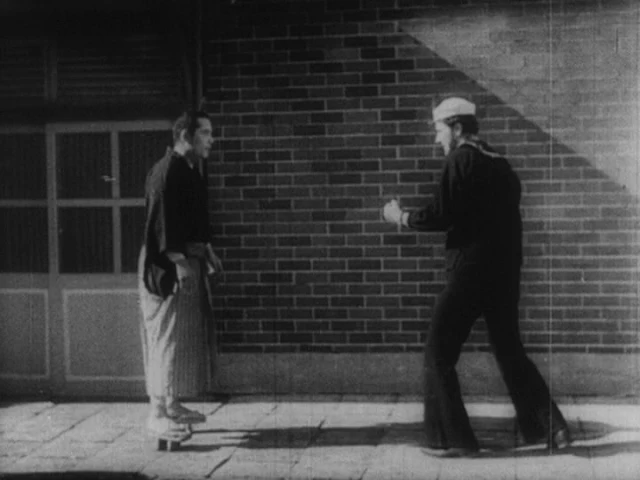 |
| Susumu Fujita and Osman Yusuf in Sanshiro Sugata, Part Two |
Shogoro Yano : Denjiro Okochi
Gennosuke Higaki / Tesshin Higaki : Ryunosuke Tsukigata
Genzaburo Higaki : Akitake Kono
Sayo Murai : Yukiko Todoroki
Yujiro Toda : Soji Kiyokawa
Yoshima Dan : Masayuki Mori
Buddhist Priest : Kokuten Kodo
American Sailor: Osman Yusuf
William Lister: Roy James
Director: Akira Kurosawa
Screenplay: Akira Kurosawa
Based on a novel by Tsuneo Tomita
Cinematography : Takeo Ito
Production design: Kazuo Kubo
Film editing: Akira Kurosawa
Music : Seiichi Suzuki
Patched together from what aging film stock could be gathered during the end-of-war shortages in Japan, and interrupted during its filming by bombing raids, Akira Kurosawa's Sanshiro Sugata, Part Two, was a labor imposed on the writer-director by the studio, Toho, which wanted a sequel to the hit Sanshiro Sugata (1943), and Kurosawa's lack of enthusiasm for the project shows. The story is routine: Sanshiro has helped judo triumph over jujitsu as the primary Japanese martial art, but he has gone into retreat for several years, honing his spirituality. But one day he comes across an American sailor beating up a rickshaw driver -- a job he once took on himself -- and thrashes the bully. This brings him to the attention of a promoter who wants to stage a fight between the judo master and an American boxer named William Lister. Eventually, after another fighter is beaten to a pulp by Lister, Sanshiro gives in and thrashes Lister, giving the prize money to the fighter who had been beaten. Meanwhile, his old opponent, Gennosuke Higaki, whom he defeated at the end of the first film, warns him that his brothers, Tesshin and Genzaburo Higaki, are out to revenge themselves for Gennosuke's defeat. They are masters of karate, which originated on Okinawa and was just making its way into mainland Japan at the time when the film is set, the late 19th century. Gennosuke gives Sanshiro a scroll depicting the basics of karate to help him in the eventual fight with the brothers. Naturally, the film concludes with a fight between Sanshiro and Tesshin -- the other brother is recovering from an epileptic seizure -- that takes place in the snow, an echo of the fight in the original film with Gennosuke in a windswept field of tall grasses. This battle is the only part of the film that shows much commitment on the part of Kurosawa, who insisted that the principals fight barefoot in the snow, not without many complaints from the actors. Unfortunately, the poor film stock, unable to provide shades of gray, turns much of this fight into a battle of silhouetted figures. Much has been made of the propaganda in the film, particularly the portrayal of the hapless American sailor and boxer, but Kurosawa, no lover of the imperial regime, manages to shift the film's emphasis to the fearsomely wild Higaki brothers.

